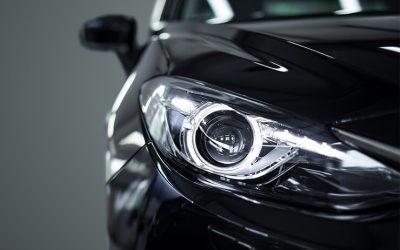Do you love driving at night to enjoy the feel of the air, the light traffic, and the lights on the roadside stores? If yes, driving at night has its fair share of risks you should beware of. One such risk is the distraction of headlight glare. Whether you have visual issues or not, it’s crucial that you learn how to avoid and reduce glare from oncoming headlights.
What Is Headlight Glare?
The term headlight glare is defined as visibility reductions or discomfort caused by viewing oncoming vehicle headlights or headlights in rear-view mirrors.
The National Highway Traffic Safety Administration (NHTSA) has received an increasing number of complaints from drivers about headlight glare in recent years. NHTSA experts explained: “Many drivers described being ‘blinded’ for a few seconds after exposure to headlight glare and needed to slow down, while others mentioned their involvement in a crash or a near miss.”
Generally, middle-aged and older drivers are more sensitive to headlight glare as their eyes adjust more slowly to changing light levels. Also, drivers who have light-colored eyes or who have had LASIK eye surgery often find this glare more troublesome.
For some drivers, headlight glare can be a persistent issue. Drivers who suffer from migraines report that this glare can trigger a migraine, or make an existing migraine worse. It also becomes a similar problem for people with any kind of vision impairments or light sensitivity.
What Are the Main Causes of Headlight Glare?
More and more pickup trucks and SUVs ride higher off the ground, so their headlights are more likely to shine directly into the eyes of other drivers. Additionally, modern vehicle models prefer to use high-intensity discharge (HID) lights, which emit twice the light of halogen headlamps but produce a blue-white light.
Also, misaligned lights are a major contributor to the headlight glare problem. Lots of vehicle models have fog or other auxiliary lights in front - and unfortunately, these lights usually become misaligned over time. Actually, misalignment is a problem that affects more than just fog and auxiliary lights. According to studies by AAA Foundation for Traffic Safety, nearly half of vehicles in states that require inspections have at least one off-kilter headlight. In addition, vehicles more than five years old are two times as likely to have misaimed headlights compared to new ones.
Driver distraction is a common factor of headlight glare, too. For example, a driver preoccupied with a phone conversation is more likely to absentmindedly forget to turn off high beams.
How to Avoid or Reduce Headlight Glare When Driving At Night?
There are a few tips to help you reduce glare and get rid of those headlight halos that plague you while driving at night.
1. Don’t look directly at the headlights producing glare.
When faced with oncoming high beams, you can look down toward the right side of the road to avoid the glare. However, please ensure that you do not take your eyes off the road completely. By slightly lowering your line of sight, you should still be able to see the lines on the road and stay in your lane until the vehicle causing the glare passes.
2. Wear protective eyewear.
Various glasses, lenses, and vehicle visors with anti-reflective material can help you reduce glare during nighttime driving. These types of protective eyewear are also called “night vision glasses” or “nighttime driving glasses.” After talking to your doctor about the best option, you can consider investing in a pair.
3. Maintain and clean all the glass parts of your vehicle.
Check your vehicle and make sure the windows, mirrors, and the inside and outside parts of the windshield are cleaned thoroughly. This step removes any form of dirt or build-up on the glass that causes light to get refracted and makes glare worse. Don't forget to keep your roof, mirrors, windshield, headlights and taillights clear of ice and snow in winter too.
Also, if you notice cracks in these glass components, especially on the windshield, be sure to make the necessary repairs right away.
4. Keep your wiper blades in good condition.
Use a paper towel and windshield washer fluid to remove the dirt and burnt rubber build-up from your wiper blades. If cleaning them doesn’t work, you need to consider getting a replacement.
5. Adjust and align your car headlights for the perfect aim.
Misaligned headlights can also be the cause of glare. Your own headlights can be a distraction when either one or both are not aimed correctly. If you start to find yourself being blinded every time you turn on your headlights, align your headlights at home or hire a professional with the necessary equipment to perform proper headlight aiming and adjustment.
6. Make sure your car mirrors are in the right position.
To set the car mirrors in a way that minimizes glare, you can follow the neat trick suggested by the American Automobile Association (AAA). First of all, bring your body to the left and place your head against the window. Then you need to move the side mirror located at the driver’s side just enough so you can view your ride’s left rear corner. Similarly, you can bring your body toward the right and tweak the position of the side mirror until you see the right rear corner of your car.
7. Use the night mode of your rear-view mirror.
Using the night setting of your rear-view mirror will reduce the amount of light coming from it so it wouldn’t be as harsh to your vision.
8. Go for an eye check-up promptly.
Vision problems can make headlight glare worse than it actually is. If you realize that headlight glare is affecting you for too long, have your eyes checked by an ophthalmologist to eliminate any problems.
9. Have a rest.
Long drives especially at night can strain your eyes, making them more susceptible to glare even from not-so-bright light beams. So if your eyes start feeling fatigued and uncomfortable, take breaks as often as you can.
10. Maintain or replace your headlights.
If you’re experiencing headlight glare, the last thing you need to be aware of is the reduced visibility from bad headlights on your own vehicle. Overall, headlight glare is something that impacts your visibility as a driver, so you don’t want to make this problem worse with foggy or broken headlights.
All headlights will experience some wear and tear over time, mostly due to sun exposure and regular use. You need to maintain and clean your headlights regularly, and even replace one pair of new headlight assemblies for better visibility.
Final Thoughts
As a driver, you should ensure that your headlights do not interfere with the safe driving of other drivers. You can help reduce traffic accidents by continuously dimming your headlights when oncoming traffic is within 500 feet.
Some drivers may not dim their headlights. In some states like Florida, you can flash your headlights briefly to tell these drivers that they are driving with bright lights on. Flashing headlights can be illegal in some states, so it's best to check your state's laws on flashing headlights before practicing.
If you have a particularly hard time recovering your normal vision after getting exposed to headlight glare, it's highly recommended to try the 10 tips above. Make the appropriate adjustments, so you can drive more safely and comfortably at night.




